When chatting about paragliding abroad the same destinations come up often: Annecy, Tenerife, Ager, Bassano. But a glance at a map of Europe shows many mountainous regions that you don’t hear British pilots talk about. Corsica, the isle of beauty, is one of these.
In the bar next to the landing field after my first Corsican XC, I was warmly welcomed by a group of local pilots to share their platter of charcuterie. “We never see British pilots here” they said.
Corsica is a large island in the Mediterranean, governed by France but with its own fiercely independent national identity. I have a special fondness for it, having spent my honeymoon there a few years back. I didn’t know how to paraglide then, but after learning to fly I often thought of the epic mountain hikes my wife and I did there, and what an amazing place it must be for free flight. The west coast in particular has mountains all the way down to the sea.
In late October 2022 I finally got the chance to check it out – we organised a mini-trip with 5 members of the Sky Surfing Club: Martin Ayers, RJ Macaulay, Scott Heffield, Stef Cahill, and myself.
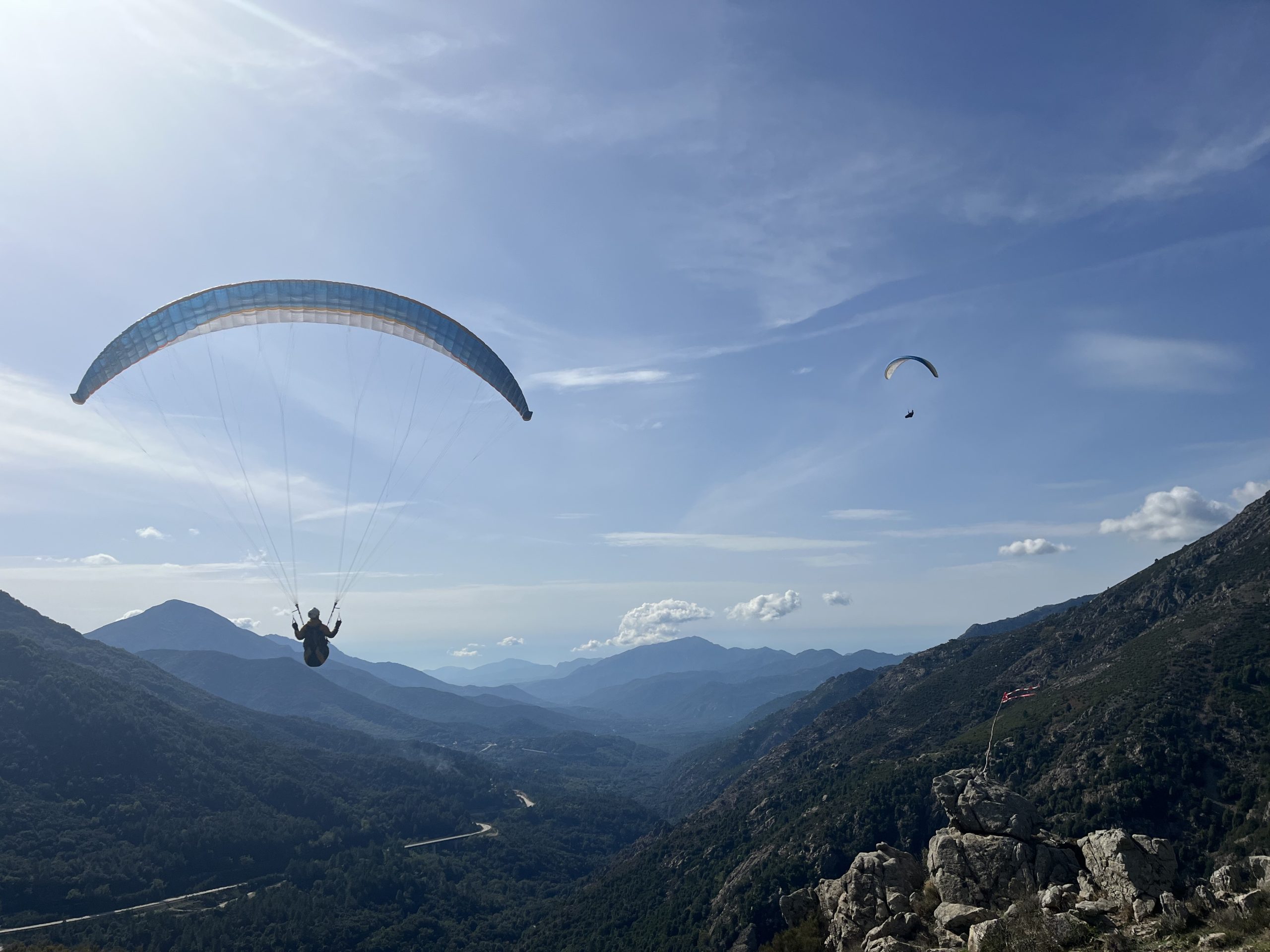
Having studied the maps, tracklogs of where people fly, and looked at where the big mountains are, I settled on Vero as the top destination: it’s near the main town of Ajaccio. The local club is called Lucif’Air (https://lu6fair.wixsite.com/lucifair) – their logo includes a little smiling chap with horns and a pitchfork. But don’t let that put you off – they gave us warm welcome. Our main contact was Maurice Etchart, aka “Momo”, a goldmine of good advice. He got us into the local telegram group, and provided links to the local weather stations.
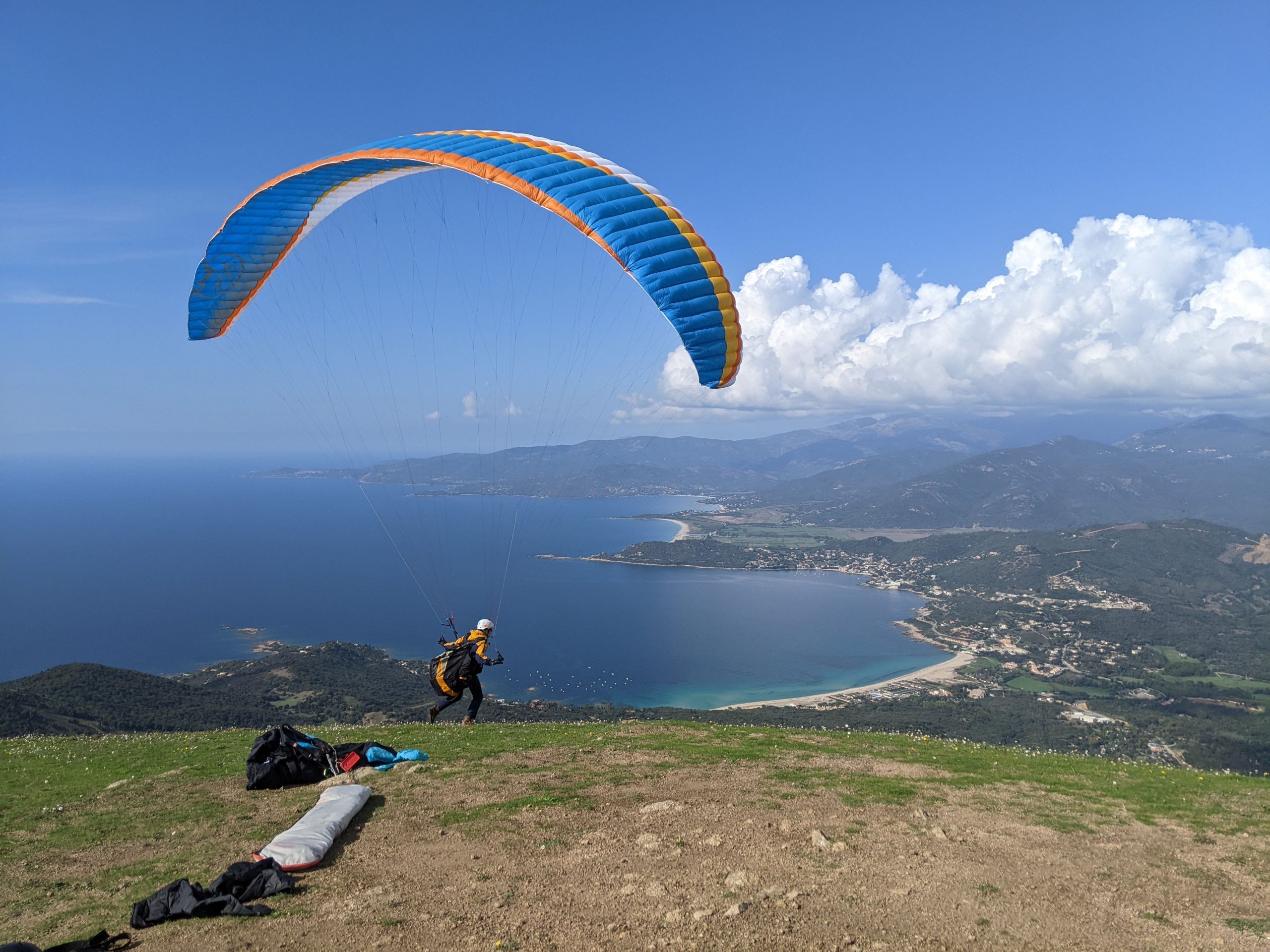
Our Easyjet flight arrived at Bastia, at the north end of the island, so we had to drive through the interior on our day of arrival. Thanks to Momo’s advice, we stopped off at Vizzavona, a wild site at the end of a valley, with a narrow landing next to the railway line. A 15-minute hike through the forest got us to take-off. Conditions looked good, with some local pilots specking out above us, but nobody else on takeoff (they had flown from the main takeoff at Vero). I spent 20 minutes untangling my lines before launching off into buoyant afternoon conditions. I scratched up the rocky mountain faces to ever more awesome views. Glimpsing over the mountain ridge to the north confirmed what the maps had told me – there’s not much civilisation round here – landing out in the valley to the north would involve many hours of hiking! The XC tracklogs show some pilots venturing into the big mountains in this direction, skirting around 2700m peaks. I didn’t feel like tackling that sort of terrain on my first flight, so I scooted off down the ridge towards our holiday home. There was nobody else about – the peace and solitude were amazing. Initially it was quite challenging transitioning from spur to spur, topping up with height on the sunny sides. Then the lift became weaker and more meditative, as the terrain went from big rock faces to gentle wooded slopes. I finally made a break from the mountain peaks into the valley when I could see my destination, only to be confounded by the valley wind – not the first time I’ve made that mistake! I landed about 200m short of my target, and walked to the bar next to the Vero landing field to join the local pilots for a drink – all 5 of them.
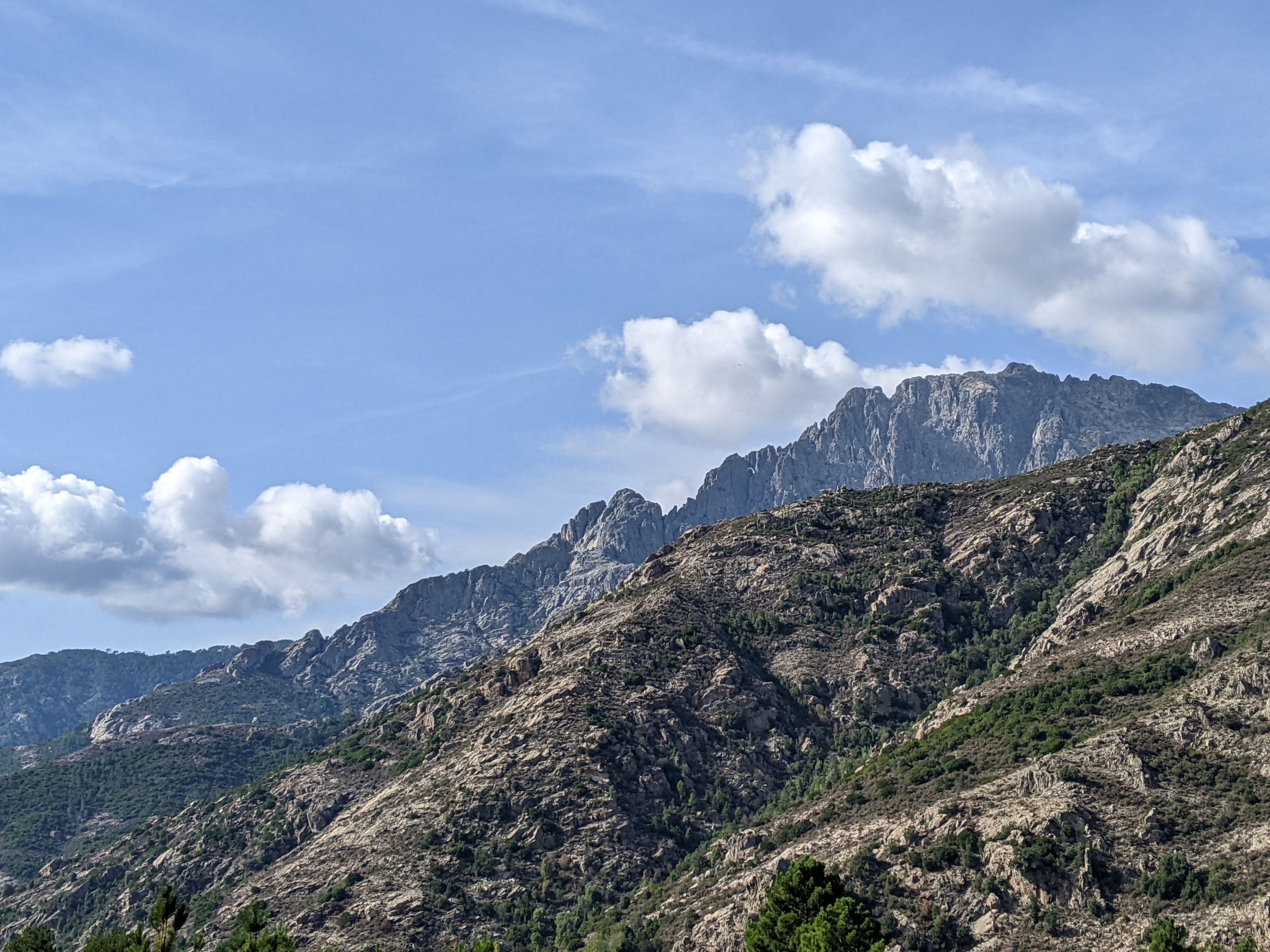
Over the next few days we explored Vero, San Bastiano, and La Chapelle. It was particularly satisfying to take off near the coast from San Bastiano and work our way up to the bigger mountains – we got as far as Punta Sant-Eliseo, next to Vero, but on a less overdeveloping day we could have carried on. The last day was very stormy inland, but we were still able to enjoy some coastal soaring with embedded thermals at La Chapelle. Many flights finished at the beach (Plage du Stagnone) where the water was sparkling clear and the perfect temperature for swimming.
We would highly recommend this area as an adventurous and uncrowded destination for experienced pilots. Less experienced pilots would still enjoy San Bastiano, La Chapelle, and Vero in less thermic times of day – but for first time XCs you may wish to go elsewhere as much of the landscape is wild and forested, so unless you’re careful and capable with landing out (or not needing to land out) you may find it too intimidating to XC. It’s not like the northern Alps or the Massif Central where you have an abundance of green fields for landing.
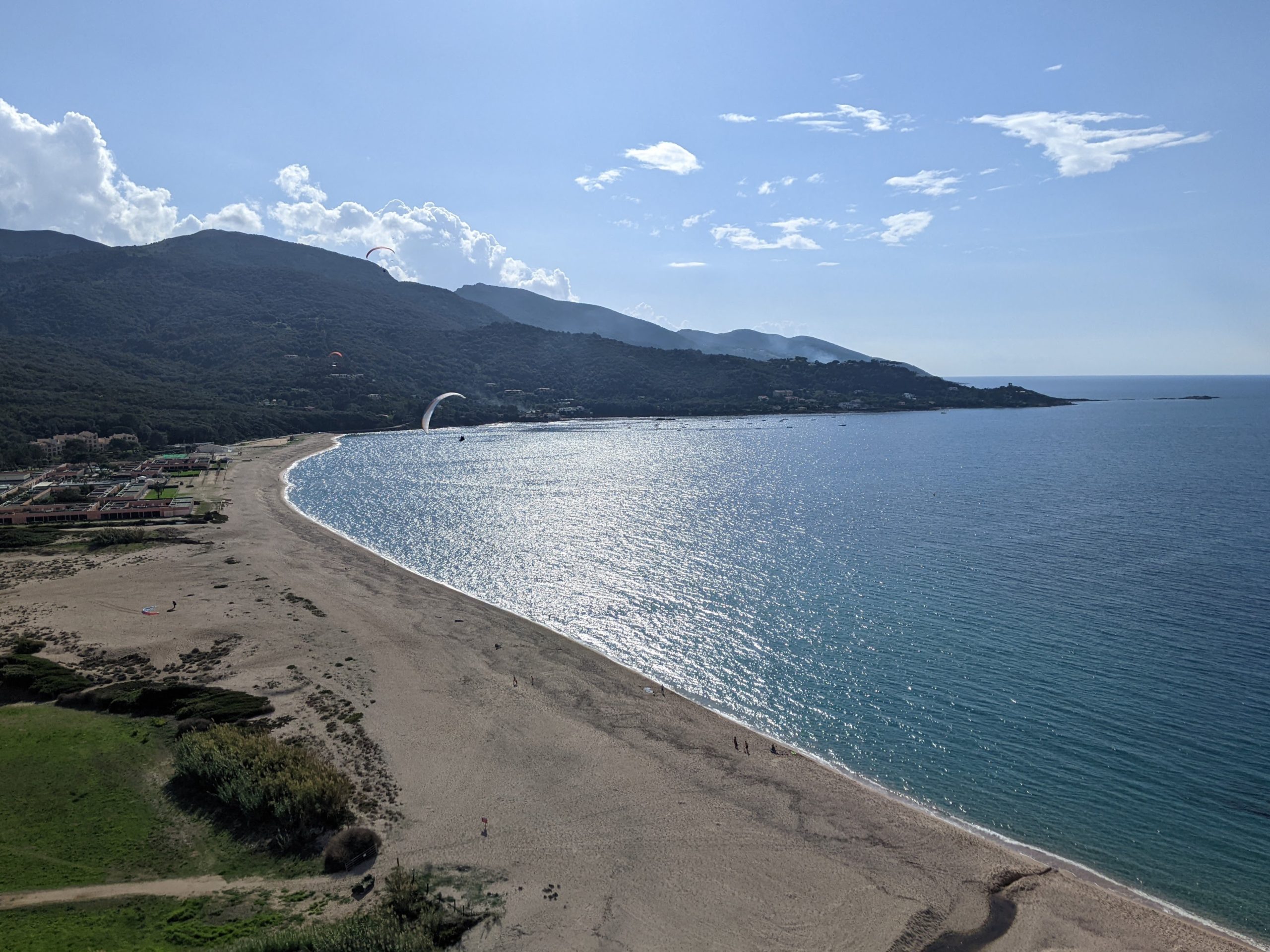
We’ll be heading back to Corsica soon – but we also hope that some will be inspired to plan their own trips – just be sure to do your homework and make contact with the locals.
WEATHER, CLIMATE AND TIME OF YEAR
« Par vent d‘Est, a la buvette tu restes », ( “When the east wind blows, to the bar the wise pilot goes”) so say the locals. In summer afternoons you’re likely to get a strong west wind blowing up the valley, which is both a valley wind and a sea breeze, but don’t confuse that with the meteo wind – if the meteo wind is east, you’re likely to get nasty conditions unless you’re just coastal soaring. Generally I would advise against the middle of summer for flying big mountains in Corsica – over-development inland is very common (ie. stormy clouds over the summits), thermals will be gnarly, and when you bomb out it will be uncomfortably hot. Spring and Autumn will be much more pleasant and manageable for the visiting pilot. Remember that early spring will still be snowy, and thermals will trigger from the snow line rather than the peaks.
WHERE TO STAY
Momo runs some Gites (French holiday homes) near Vero, with access to communal gardens and a swimming pool. Book at https://www.gites-de-france.com/en. The Gites are numbers 14961,14962,14971,14972 and 14973.
WHERE TO EAT
The Merendella Restaurant is just about the only option near Vero. It’s wonderfully uncommercial – only open a few days each week, unpromising décor, very limited menu, full of locals, and serves simple Corsican food made with exquisite quality ingredients.
MAPS
Geoportail.gouv.fr has IGN maps (the French equivalent of OS maps). If you choose the “Carte Topographique” (topographical map), you’ll see it has most paragliding takeoffs marked with a pink paraglider symbol.
SITE GUIDES
Detailed site guides are available at https://lu6fair.wixsite.com/lucifair. The FFVL also have a database of sites covering all of France.
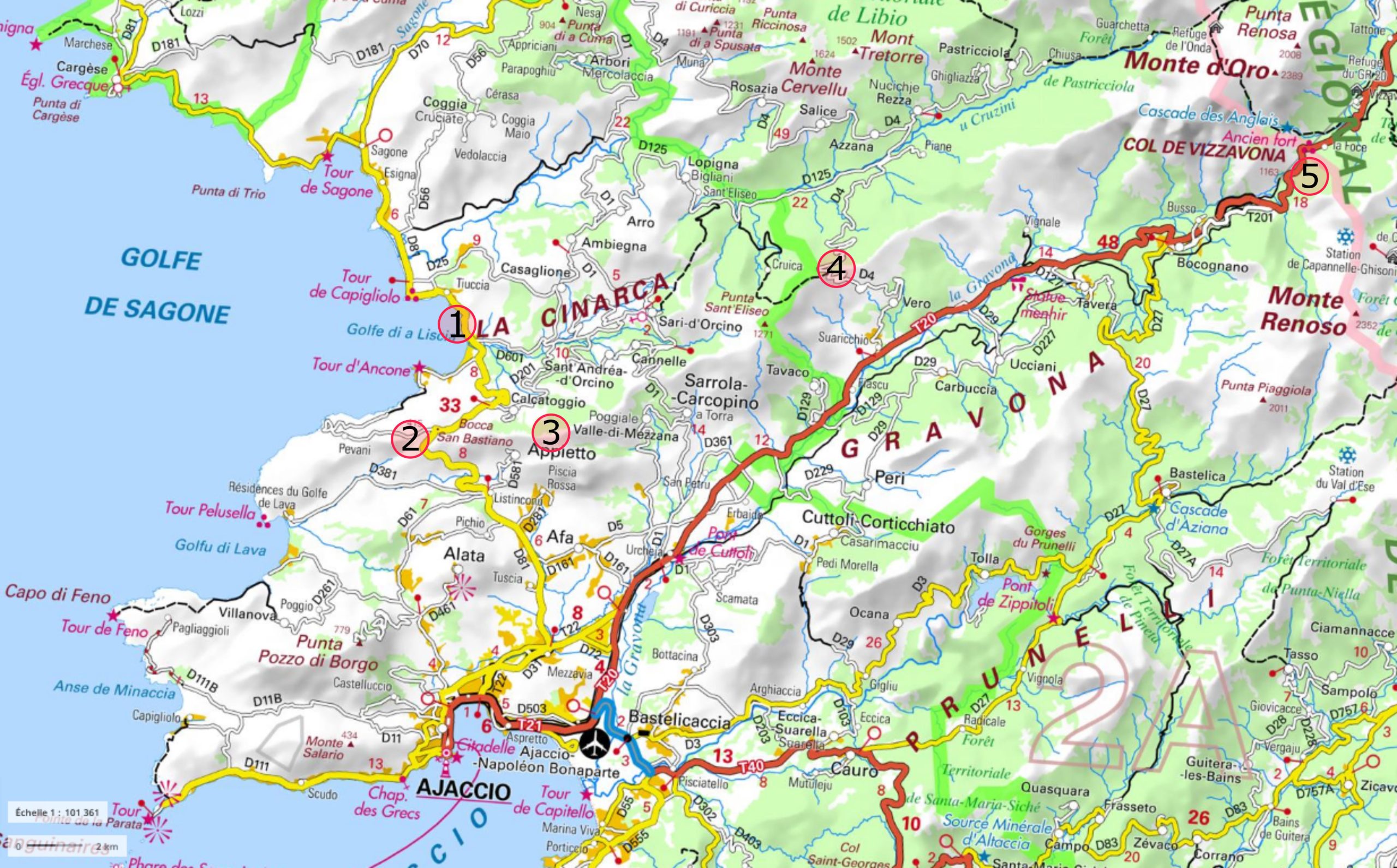
1 Plage du Stagnone landing
The perfect way to finish your mountain XC flight – be sure to pack a towel and swimming shorts in your harness. There’s even a nice bar in the campsite behind the beach. The rules state that you must land at the far end beyond the big hotel complex, on the scrubby grass or sand just before the water treatment centre. Don’t land in front of the hotel complex, nor on the campsite lawn.
2 La Chapelle
A ridge next to the Chapelle San Sebastiano – take off next to the Punta Vida. Easy coastal soaring with the odd embedded thermal. Very easy to glide here from San Bastiano. If you bomb out on the beach and want to walk up for another fly, this is a good option.
3 San Bastiano
A grassy dome with take off possible in any direction. A 20 minute hike from the village of Appietto. Landing is either at the beach (Plage du Stagnone), back at the village next to the chapel San Chirgu, or in the valley to the south just beyond the roundabout (don’t go further south or you’ll hit restricted airspace from Ajaccio airport). We found that San Bastiano worked well even when storms were brewing inland – the sea breeze kept them at bay (or away from the bay, I should say).
4 Vero
A carpeted takeoff and big landing field next to a bar (cash only). The main takeoff, giving you access to the south east face of the Punta Sant’Eliseo mountain, at 1271m. The eastern aspect helps it start working earlier in the day than other launches.
5 Vizzavona
A springboard to the high mountains. Takeoff is a lovely 15 minute hike through the forest. Landing is a little tight right next to the train track.
The locals tell us that summer evenings can give lovely easy and smooth flying here. At 4pm in October, we found it still quite thermic and a bit technical, good as a serious XC launchpad.
